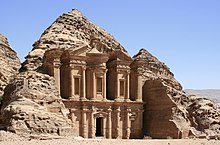Ed-Deir, Petra
 ed-Deir | |
 | |
| 30°20′16″N 35°25′52″E / 30.33778°N 35.43111°E | |
| Location | Petra, Jordan |
|---|---|
| Type |
|
| Width | 48 m (157 ft) |
| Height | 47 m (154 ft) |
| Completion date | mid-1st century AD |
| Opening date | yes (only from outside) |
| Dedicated to | Obodas I (?) |
Ed-Deir (
Arguably one of the most iconic monuments in the Petra Archaeological Park, the Monastery is located high in the hills northwest of the Petra city center. It is the second most commonly visited monument in Petra, after the
The huge façade, the inner chamber and the other structures next to it or in the wider area around the Deir probably originally served a complex religious purpose, and was possibly repurposed as a church in the Byzantine period.

Location
The Monastery can be reached by ascending a nearly 800-step path (40-minute walking time) from the Basin. The Wadi Kharrubeh, the Lion's tomb, and small
Exterior design
Scholars believe that the flat area in front of the Monastery was levelled through human action in order to make the area suitable for social gatherings or religious occasions. Near the entrance of the structure are the remains of a wall and a colonnade.[5]
The rock-cut
Interior plan
The interior layout of the Monastery consists of a single square chamber with a broad niche in the back wall. Each end of this niche contains four steps, and the niche itself is framed by pillars and a segmental arch.[7] The room is thought to have been painted and plastered, even though none of these decorations have survived into the modern day.[8]
Architectural style
The monastery is an example of Nabataean architecture. Its blending of architectural styles is a hallmark of the dynamic and hybridised nature of Petra as a whole.[3]
Architecturally, the Monastery follows classical Nabataean style, which is represented by a mixture of
Mesopotamian style is evident in the single, large entrance and the plain, window-like depressions of the facade. The door to the main chamber of the monastery is 8 metres high and provides the sole portal for the entry of light into the structure. The presence of square-topped tower structures on either side of the Monastery also demonstrate the Mesopotamian influence present in the structure.[citation needed]
Purpose
Nabataean
The role of the Deir, which has been probably built in the mid-1st century CE,
An inscription that was found on the wall of a nearby structure while it was being cleaned in 1991, mentioned "the mrzh' of Obodat the god".[11][4] Mrzh' is interpreted as a private religious group with a limited number of members.[11] The inscription is located too far from the Deir, but may possibly indicate that the entire Deir complex was dedicated to the Nabataean king, Obodas I,[11] who was deified posthumously.
Byzantine period
The tomb has several incised crosses carved into the wall, which may indicate that the structure was reused as a church during the Byzantine period.[citation needed]
3D documentation with laser-scanning
The Monastery was spatially documented in 2013 by the non-profit research group
In popular culture
The Monastery has appeared in several Hollywood movies, such as the 2009 film Transformers: Revenge of the Fallen.[citation needed]
See also
References
- ^ "Petra, Jordan". Martin Gray. Archived from the original on 21 August 2010. Retrieved 2010-08-20.
- ^ a b c Gunther, Michael D. "ad-Deir (Monastery)". Old Stones: The Monuments of Art History. Retrieved 10 June 2020.
- ^ a b Sanchez, Cruz. "Petra Lost and Found". National Geographic. Archived from the original on April 8, 2018. Retrieved May 13, 2019.
- ^ a b "Petra: The Deir". Nabataea.net. Retrieved May 13, 2019.
- ^ "The Monastery". National Geographic. Retrieved May 13, 2019.[dead link]
- ^ Markoe, Glenn, ed. (2003). Petra Rediscovered: The Lost City of the Nabataeans. New York: Harry N. Abrams in association with the Cincinnati Art Museum.
- ^ Mckenzie, Judith (1990). The Architecture of Petra. New York: Oxford University Press.
- ^ a b Macaulay-Lewis, Elizabeth. "Petra: Rock-cut Facades". Khan Academy. Retrieved 10 June 2020.
- ^ "Architecture in the Hellenistic Period". Boundless. Retrieved May 13, 2019.
- ^ ISBN 9789004301481. Retrieved 10 June 2020.
- ^ ISBN 9789004216235. Retrieved 10 June 2020.
- ^ Rüther, Heinz. "An African heritage database, the virtual preservation of Africa's past" (PDF). www.isprs.org.
- ISSN 0001-9933.
- .
- ^ "Site - Petra". zamaniproject.org. Retrieved 2019-10-28.
External links
- Documentary about its construction at the Internet Movie Database
- Photos of ed-Deir at the Manar al-Athar photo archive
